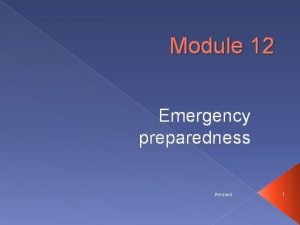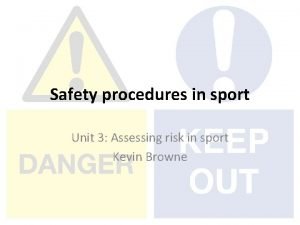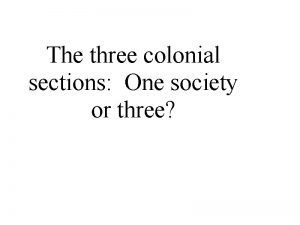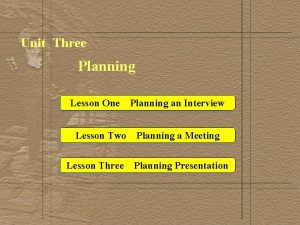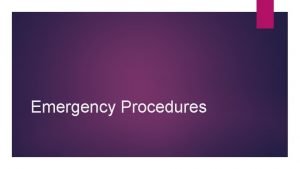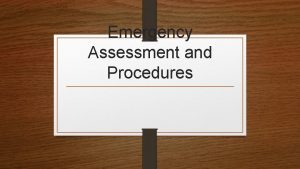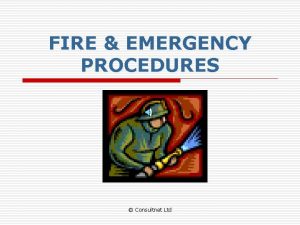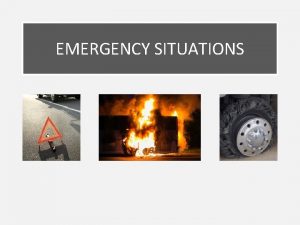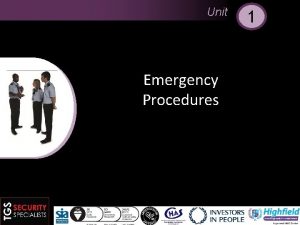Emergency Procedures Unit Three Lesson One Emergency Procedures










- Slides: 10

Emergency Procedures Unit Three, Lesson One - Emergency Procedures Slide 1

Life. Threatening First Aid Emergency Procedures • If an infant or toddler in your care… – is unconscious and nonresponsive – is having trouble breathing or is not breathing – has no signs of circulation – has severe bleeding – can not move his or her arms or legs …take immediate action! Unit Three, Lesson One - Emergency Procedures Slide 2

What To Do In a Life. Threatening Emergency • Stay Calm and use the “Three C’s” – Check – Call – Care Unit Three, Lesson One - Emergency Procedures Slide 3

Check • Check the scene – Ensure the scene is safe (if not, move to safety) – Look for clues that might tell you what happened (poisons, broken toys, etc. ) Unit Three, Lesson One - Emergency Procedures Slide 4

Check (cont. ) • Check the victim – Tap foot (infant) or shoulder (child) and shout victim’s name – Check for other life-threatening emergencies: • Breathing • Bleeding • Broken Bones • Bruises • Burns • Other To protect both you and the victim, avoid contact with body substances or fluids, known as Body Substance Isolation (BSI), whenever possible. BSI procedures assume that all body fluids are a possible risk; use gloves and/or breathing barriers, if available, and always wash your hands after care. Unit Three, Lesson One - Emergency Procedures Slide 5

Call • Call 911 or your local emergency number – If you are alone and the victim is under eight years old and not breathing, begin CPR for the first minute, then call 911 or your local emergency number – Use a landline versus a cell phone whenever possible Unit Three, Lesson One - Emergency Procedures Slide 6

Call (cont. ) • If someone is with you, have them call 911 or your local emergency number while you provide first aid care • If the problem is not lifethreatening but might get worse soon, call the parent(s)/guardian(s) Unit Three, Lesson One - Emergency Procedures Slide 7

Care • Care depends on the medical problem • Always care for life-threatening emergencies first: 1. Breathing (ensure breathing first) 2. Bleeding (control all emergency bleeding second) 3. Broken bones (always suspect a neck or back injury) 4. Bruises (internal bleeding) 5. Burns (1 st degree burns are mild, followed NOTE: The next lesson will help you identify first aid situations and action plans you by as 2 nd and 3 rd degree burns) can take a caregiver. Unit Three, Lesson One - Emergency Procedures Slide 8

How To Call For Help 1. Call 911 or your local emergency number 2. Tell the dispatcher you have an emergency 3. Give the dispatcher the following information: • Number of people • Address • Cross streets injured • Phone number • Type of care administered Unit Three, Lesson One - Emergency Procedures Slide 9

How To Call For Help (cont. ) 4. DO NOT HANG UP!! Wait for dispatcher questions and further instruction 5. If someone is with you, tell them to go outside and meet the ambulance/medical services 6. Call the child’s parent/guardian as soon as possible and let them know what happened Unit Three, Lesson One - Emergency Procedures Slide 10


